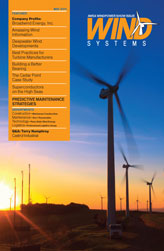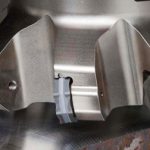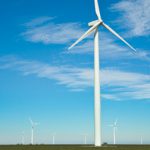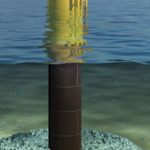Wind industry project development is a dynamic business. One of the key challenges is identifying and securing project sites. What makes a site attractive can vary from state to state. Good wind is essential, of course, but access to transmission, ease of permitting, and community support can also be important factors. This case study examines the development of one project that is currently under construction: Cedar Point Wind.
Location, Location
In 2004 Renewable Energy Systems Americas, Inc. (RES Americas), worked diligently to analyze wind resources and identify wind project sites in Colorado. The company’s in-house experts, a team of experienced wind analysts, focused on a ridgeline running through Lincoln and Elbert counties in northeastern Colorado. Figure 1
Eastern Colorado is a sparsely populated area. The plains experience extreme weather throughout the year, ranging from whiteout blizzards to hailstorms and tornadoes. The land is fertile and has yielded generations of cash crops for family-owned farming operations. It is also a region of blustery winds. This, combined with its proximity to the Denver load center, made it an attractive prospect.
RES Americas, a company that takes risk assessment very seriously, had to ensure the Cedar Point Wind Project had all these attributes: a strong, consistent wind resource, available transmission capacity, and a welcoming community with available land. The Cedar Point site passed with flying colors. Four years of wind data and research confirmed the reliability of the power generating resource, but the biggest challenge ahead would be leasing 20,000 acres of private property from multiple owners, some whose families had lived in the area for generations.
A Topographic Jackpot
The tipping point for RES America’s quick move to develop Cedar Point was the geographic characteristics of the land; it was unique, even in renewable-friendly Colorado. RES Americas estimated that the site could accommodate 139 turbines, or roughly 252 megawatts (MW).
Kara Cubbage, lead developer for the project, says that “Cedar Point was a distinctive opportunity. It was a topographic jackpot. Our wind data was great and created an enormous amount of internal excitement and support for the project. Approaching the landowners and residents of the tri-county area would be the next major obstacle in getting this project off the ground and headed in the right direction. Early stage development was competitive in the region. We had to make our case to this community that Cedar Point was a candidate for successful and timely development.”
Fortunately for Cubbage and RES Americas, residents in the area embraced the project from the onset. Initial leasing began in 2003, and within a year most of the land for the project was under contract. By 2007, all leasing was complete. The flat land, primarily utilized for agricultural operations, was determined to be more than suitable to host turbines and transmission facilities.
Community Relations
RES Americas made a commitment at the onset of project development to community relations. The company understood that winning over local residents and the business community in the area was as important as having landowner partners. Figure 2
Through a series of open houses and other public meetings, largely led by Cubbage herself, the project saw little to no resistance in the community or through the complex permitting process. Area residents recognized the community benefits immediately. They learned that construction alone would bring 100-200 temporary jobs to local contractors, and up to 12 full-time jobs after the site was operational. The area tax base would enjoy expanded revenue to benefit local schools and promote economic development in surrounding communities. Pat Vice, executive director of Lincoln County Economic Development, says that “The generation of electricity from wind produces revenue for farmers and ranchers and benefits rural communities by the creation of new jobs during construction, for ongoing maintenance, and as tax revenue supporting local schools and hospitals.”
Transmission and Offtake
Like most states, Colorado is diligently working on the expansion of transmission capacity to carry much-needed power from generators—whether renewable or fossil fuel—to load centers where it will be used. Windy sites are not always right next to substations or other points of interconnection to the electrical grid. This was the case with Cedar Point, and it posed a significant hurdle.
The RES Americas team faced a great challenge in identifying a spot on the grid where power could be delivered upon project completion without additional grid construction, which could be a very costly endeavor. After further analysis it was determined that the project would be able to connect to an existing Public Service Company (PSCo) 230k transmission line at the Missile Site Substation, just north of Deer Trail. In order to gain access, RES Americas would need to construct 42 miles of private transmission to link the project to the grid. A majority of the path for this proposed line follows the right of way path for a previously proposed line, the Eastern Plains Transmission Project, making the daunting task a much easier assignment. Nonetheless, it took several months to secure the rights of way for 42 miles of easements.
By 2010 it appeared that Cedar Point was well on its way to becoming a reality. The wind resource had been confirmed through years of measurements. The leasing agreements were finalized. Rights of way had been obtained, and permitting was nearly complete to begin construction of the project and transmission line. However, the project wouldn’t be built until there was a buyer for the power to be generated.
Through a national movement spurred by the American drive to free our country from foreign energy sources and to make use of our renewable energy assets, states have adopted renewable standards for utilities servicing their state. Colorado has been a leader in adopting such standards.
Cedar Point was a project of significant size that would have value to a utility working to reach the required renewable standards of 30 percent by 2020. Cedar Point, along with two other projects, won the 2009 renewable power procurement process run by PSCo. Figure 3
In March of 2010, RES Americas executed a 20-year PPA with PSCo under which the utility agreed to buy 252.2 MW of clean power from Cedar Point. “The Cedar Point Wind power purchase agreement is the first to be completed from the 2007 Colorado Resource Plan by Public Service Company of Colorado, an Xcel Energy company. The project will expand the utilization of Colorado’s desirable wind resource into another region of the state to deliver this clean wind energy to our customers,” said Tom Imbler, Xcel Energy vice president for commercial operations, at the time the PPA was announced. “Not only will this project help us to meet our renewable energy standard for Colorado, it will be our first wind energy purchase from a facility constructed in Colorado with wind turbines manufactured in Colorado.”
Selling Point
RES Americas made the strategic decision to sell the project to a new owner while retaining engineering, procurement, and construction rights. This would allow the company to realize value from the project while freeing resources to focus on other projects in its development portfolio.
Once the PPA was finalized, the bidding process to own the project intensified. RES Americas reviewed a number of bids from several prospective owners. Ultimately, the $500 million project was sold to Enbridge, Inc., a Canada-based energy company with American affiliates.
“Renewable energy aligns very well with our objective to profitably grow our energy infrastructure business,” according to Al Monaco, executive vice president, major projects and green energy at Enbridge. “The investment in Cedar Point bolsters our already strong portfolio of green energy projects and establishes a beach head for future investment into the growing U.S. green energy market. We expect to continue to grow our renewable portfolio, particularly in states such as Colorado that support green energy development.” Figure 4
Breaking Ground
The Cedar Point Wind Project officially broke ground on August 25, 2010, more than seven years after the early stages of development had begun. RES Americas is serving as the engineering, procurement, and construction contractor for the site, and on completion it will operate the project for at least two years.
Just over nine months into construction, RES Americas is poised to deliver ahead of schedule. In this part of Colorado, harsh winters and weather can play a significant role in construction. RES Americas understood this variable in the construction timeline and planned accordingly. “Luckily the weather has been very cooperative, so much so that the transmission line was completed ahead of schedule and the turbine deliveries began almost a month ahead of time. We are continuing to stay focused on the tasks at hand and stay ahead of schedule,” says Jason Zingerman, vice president of construction at RES Americas. Figure 5
During the early part of the construction phase all efforts were focused on infrastructure, excavation, and foundations. Each foundation was comprised of nearly a half-million tons of concrete and rebar, requiring an immense amount of earthmoving and backfilling with aggregate material.
Tower installation and erection started in March of 2011 as the winter season began to fade and electrical infrastructure neared completion. All the wind tower components for Cedar Point are being manufactured in Colorado by Vestas Wind Systems. Figure 6
Local subcontractors were heavily engaged during excavation and road construction; nearly 100 local jobs were created to complete these tasks. “We’re excited about being part of this community,” says Zingerman. “Really, this is the community’s project and everyone has been very supportive during the construction phase.”
The Future
RES Americas and Enbridge expect that the project will begin commercial operation in November of 2011. Once completed, Cedar Point will consist of 139 1.8 MW Vestas V90 turbines, two onsite project substations, an operations and maintenance building, and over 42 miles of an electrical transmission line. It will be the second largest wind project in Colorado and is contributing to the state’s economic development.
Vestas has recently announced plans to hire more than 1,000 people in Colorado by the end of 2011, largely due to projects like Cedar Point. Colorado is one step closer to reaching the renewable standards goals designated by former Governor Ritter and the landmark legislation requiring 30 percent renewable by 2020. Cedar Point will yield approximately 875,000 MWh, roughly the annual energy consumption of around 80,000 Colorado households. The project will displace fossil generation, keeping approximately 710,000 tons of CO2 per year out of the atmosphere.
The Cedar Point Wind Project is a great accomplishment for both Enbridge and RES Americas. The project will bring the RES Americas constructed/under construction portfolio to over 5,200 MW and is the company’s first large project in Colorado. Cedar Point is Enbridge’s seventh wind power facility and brings the total generating capacity of their green energy projects to 810 MW. More importantly, it is a significant accomplishment for Colorado. It is a project that was born in state, developed in state, constructed in state, and will operate in state to benefit Coloradoans.








































